 |
||
|
||
| ||
Since the DOOM was released in 1993, shooters have been growing both in quality and in the number, an image has become more detailed. In the constantly changing world of the First Person Shooter (FPS) there is only one steady component - a barrel. Or it can be replaced by a hand, or by a tail like in the Alliance vs. Predator. Gamers are constantly spending their money for making a picture more lively. But in the right and below it is almost always immovable, because without a barrel playing wouldn't be so convenient: in such a way the human's mind is built. People have been reflecting on mechanisms of visual perception of the reality since earliest times, but only 60 years ago they started to invest it. That time America needed a lot of good pilots, who could be trusted with a strategic bomber or a carrier-plane (landing is a serious task, especially when an airdrome is floating and rocking). The problem is that a part of cadets-volunteers don't suit flying. It is impossible for doctors to select them out in advance, as well as for institutions to teach all of them. If physically they are equal and their behavior is different, then the problem lies in their psyche, doesn't it? So, the scientists started studying the laws of perception of the reality. Many years later, after the Second World War James Gibson introduced its "Ecological approach to the visual perception". The word "ecological" means that the vision's role is estimated from the natural selection standstill. Why did it appear? Because it improves an adaptability: a blind man stands less chances to survive. What's the uniqueness of the vision? It makes possible to feel objects and media without contacting it. A man is scanning all around it all the time looking for new information. A luminous flux on the retina is constantly changing. As soon as the form of light spot edges, ratio of their colors, brightness and contrast coincide with the scheme recorded in the genetic memory (it is called invariant), an image arises in the human's picture of the world. Gibson has created a detailed, logic and ready-to-use theory. Its most popular and consistent application is the First Person Shooter. Below you can see what we have got holding the book and looking at the screen: 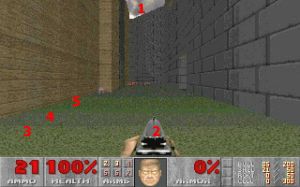 An invariant of the sky [1] (the picture is from DOOM, the text is Gibson's) - a texture with a blurred image, immovable in case of longitudinal and cross transitions but turning together with the head (a color is unimportant). If a man sees it above him, it behaves as if there is a real sky above. The most important is the invariant of Presence [2]. In a real world it is a tip of a nose. It always takes the same position in the field of vision. One perceives movements of the visible world with respect to this diffused spot. In the DOOM its role is played by the end of the barrel. As soon as the psyche takes it as an invariant, a gamer gets into the First Person Shooter's world (FPS). This one - [3, 4, 5] - is an invariant of remoteness: the further the texture, the more gray it is. In the real world the objects' color is altered by the air and dust in it. When townspeople come to mountains (the atmosphere is rarefied and dust is nearly absent), this invariant causes a mistake: mountains seem to be closer than they really are. The picture shows seven gradations of the color. If you press your finger against the screen (right on the gray stripe next to the barrel's tip) and press "up" and "down" buttons several times, the virtual world will move, and this strip won't. In the modern games the function of a remoteness invariant is implemented also by mip-levels, with the color changing more gradually. On the pictures below you can see the Unreal. The same fire source has different colors in the distance and nearby. 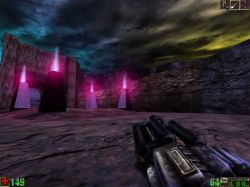  In the reality the color's life is more queer. For example, the color of the switched off monitor seems to be lighter than the color of this text. What an image is built of: invariants and superfluous information or only of invariants - in the most cases it doesn't matter much. The given set of invariants must help us solve the problems of the current activity. For example, for an undemanding music lover an mp3 is equal in quality to a CD. But a studio work requires original audio CDs. A realistic nature of an image depends on the painter and his abilities to collect this image from invariants. 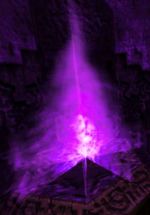 It can be clearly seen on uncomplicated objects, for example, a flame or a water surface. For the first time a 3D image of fire appeared in "Hexen II" and "Quake". A fire source was small (torch). One should look at it from a distance, from below or from the side. At a close look the flame looks like several cyclically changing light figures similar to quadrangular pyramids with broken edges. One cycle lasts around one second.  The next level is "Unreal". Here we use the whole set of invariants. A candles' image is created with an immovable triangular pyramid. A larger fire's image is implemented with a torch which is formed with 4 vertically directed thin flat figures. They have the same form close to a right triangular. They touch each other by their legs which are perpendicular to the floor. The other legs are lying in a plane parallel to the floor. From the above the torch looks like a cross made of lighting lines. When a torch is situated near a wall, the cross becomes flattened looking like "X". A larger fire source is made of 6 triangles, the largest one use 8 ones. Along the triangular surface we can see waves coming bottom-up, sometimes they are spreading from the right angles. Approaching a hypotenuse, the waves become transparent, invisible. The fire can be of nearly any color: red, yellow, blue, purple. It depends on the distance between the point of observation and a fire source. White and green colors are not used since white is taken as vapor, and green makes the flame look like water. 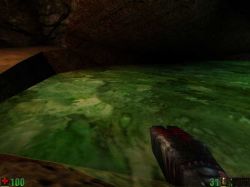 Water (liquid surface) is usually formed of complex moving patterns on the surface (according to Gibson). A type of liquid depends on their speed, be it water, spirit or oil. Shallow puddles are the most realistic. When a surface grows larger, an image sometimes loses its steadiness. As a matter of fact, in statics or at the unusual visual angle an image is unconvincing. It seems strange that a human being can take these queer objects as water and fire. Nevertheless, it happened numerous times. It should be noted that invariants were known long before Gibson. In the end of XIX - beginning XX many painters made experiments with color and form. In 1918 Malevich participated in decoration of the Red Square for a parade. Today the classic style falls behind the avant-guard in the commercial cost. Refusal a photographic similarity in favor of a psychological one is well noticeable in the 3D world. A man perceives only those events which are connected with survival. The visual world lacks substance conservation laws. Water from a puddle disappears in a sunny day, so does a lump of sugar in a cap of hot tea. In the virtual world ammunition disappears when a gamer approaches them - and this doesn't causes a loss of realism. A man rarely examines something motionlessly. Usually the whole body participates in this process: a man comes closer or moves off, inclines his head, turns an object in his hands (he defines invariants). The fuller we use skills of reality building in the virtual world, the more convincing will be this world. First the sense of reality was created with the System of virtual reality (a helmet and a Jaron Lanier's glove device). Then (according to economical reasons) a sensor of a helmet's position in the space underwent the reduction. First, a keyboard was added. In 1998 a mouse joined this system ("Quake II", "Unreal"). This solution is based on the principle of a block structure of the psyche and mind. It turned out that it was simpler to learn a gamer to replace one block (controlling muscles of hs neck and eyes) with another (controlling movements of his finger tips) then to make him buy a helmet. The psychological method of block replacement was first tested in the military hospital in the Urals more than 50 years ago. It was necessary to breathe into injured soldiers a normal life. A neurosurgeon can extract a splinter or a bullet but he can't restore a lost part of the brain. However, it can be emulated. For example, after a cranial injury a man can't walk, though his legs are all right. He is taught to step on pieces of paper thrown about on the floor. This is another block - if it remains intact, then the man can move his legs. After that he is taught to imagine these pieces of paper on the floor. Some time later he easily walks without thinking about it. The main thing is to know what can be replaced by what. The War gave a lot of data for it. So far scientists all thoughtout the world come to Moscow to participate in readings devoted to the founder of this theory - Alexander R. Luria. The second stage of the helmet reduction is refusal a stereo image. Comparing an angular resolution of the retina limited by the sizes of cells it consists of ("cones" and "rods") and the distance between the eyes, it makes clear that a man sees the world flat already at the distance of 3-4 meters from his face. At the greater distance the differences of object's projections on the retina get smaller than the size of cells-photoreceptors. There is still an optical difference but it can't change the retina's state, that is why a man doesn't perceive it. Stereo vision is not intended to provide SD effect, it has another function - to improve image sharpness, to enlarge an angle of observation and compensate a black spot of each eye (a black spot is the place where a visual nerve goes out of the eye, here the perception of the exterior world is completely absent). As a result, a modern virtual world's navigator looks steadily at the monitor, listens to the sound coming from speakers, working at the same time with both hands. The right hand moves in the horizontal plane with an amplitude of 1-2 cm, tips of the middle and index fingers press the left and right buttons of the mouse. The left hand lies on a keyboard, tips of a middle, index and fourth fingers press primarily three buttons all the time. As soon as a picture frequency exceeds 25-30 fps, a gamer starts feeling a reality of the virtual world. And the role of finger tips is not less important than that of eyes. The sense of reality is based not only on the visual information. The body's sensations also contribute to it. A block structure of the psyche makes possible to emulate them at the expense of other perception channels. A functional body state (readiness to the definite activity) is transferred via a visual data channel. First, this problem was solved with the help of a percentage indicator. It also exists today, but now in case of sharp changing in a functional state, the whole screen becomes an indicator. First of all, I mean disabling of a gamer. At this moment in any popular FPS a screen blazes up. Fire injuring is coded with red color since the DOOM times. Lack of oxygen is coded with white color (Unreal). Poisoning - with green color (Daikatana).  The right picture shows an artifact that gives a temporary immortality in the DOOM II . After a gamer touches it, the world becomes black-and-white. A safety environmental-suit paints the world in green. A technically more complicated coding is implemented not with color, but with rocking of the field of vision. 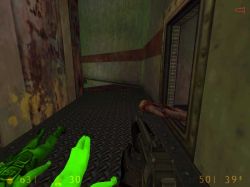 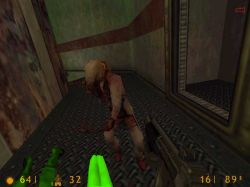 The left picture shows a normal state of a gamer (Half-Life), the right one shows the state right after injuring. As compared with a color method, this one is more rough and powerful. It is difficult to tell the injuring type with this method, but the effectiveness is higher. It is well noticeable in the scene with fish. Normally, a man knows that a real world will remain at rest however he may turn his head. He even perfectly understands what's happening behind. Bad poisoning (for example, with spirits) - and the world starts "storming". It is not the man that falls, it is asphalt that prances. As a rule, a man feels a discomfort. On the whole, the tendency of complication is typical not only of functional state coding but also of coding of environmental data. Changing of airspace by water was earlier marked only with color (blue-green). Probably, one of the most ergonomical solutions was Unreal. After that color was supplemented with jerking of the field of vision. After ducking in the Quake III Arena an image starts rhythmically (a period of 1-2 sec) contracting and stretching in vertical and horizontal directions by a couple of percents. This pulsation is less noticeable than rocking in the Half-Life, that is why I can't show them here. As a conclusion, I should notice that however graphics engines and video accelerators may change, a part of a screen on the right and below will remain immovable. And as for the X-Box, we should expect "thickening" of a visual thread between a screen and a man.  New resource-hungry invariants will soon become popular. Judging by the screenshots of the Unreal-2 - they will be new fire sources. Besides, new gaming events and media will also soon appear. The strength of shooters lies in the concept "first
person". Watching a hero from the side and being in his boots are
different things. This article describes different mechanisms
ensuring a psychological identity with a hero of games. In the next
articles you will get know why and what for people navigate
the virtual worlds.
Write a comment below. No registration needed!
|
Platform · Video · Multimedia · Mobile · Other || About us & Privacy policy · Twitter · Facebook Copyright © Byrds Research & Publishing, Ltd., 1997–2011. All rights reserved. |